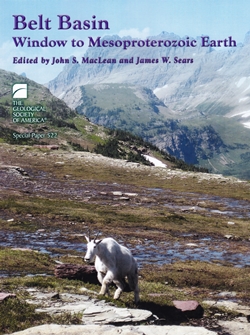 This book provides a detailed review of aspects of the Belt Basin, which covers around 200,000km2 of Montana, Idaho and adjacent Canada. The basin fill is around 20km of mainly clastic sediments deposited between 1500 and 1370 Ma in an intracontinental rift basin that subsequently underwent numerous episodes of tensional, compressional and strike-slip tectonism and igneous activity until the Miocene. Despite metamorphism to greenschist grade, sedimentary structures are well preserved.
This book provides a detailed review of aspects of the Belt Basin, which covers around 200,000km2 of Montana, Idaho and adjacent Canada. The basin fill is around 20km of mainly clastic sediments deposited between 1500 and 1370 Ma in an intracontinental rift basin that subsequently underwent numerous episodes of tensional, compressional and strike-slip tectonism and igneous activity until the Miocene. Despite metamorphism to greenschist grade, sedimentary structures are well preserved.
The first four papers examine aspects of stratigraphy and sedimentology, including whether the sediments were lacustrine or marine - not easy in successions where fossils are rare at best. Likely environments in parts of the basin were playa lakes and flash floods across land surfaces devoid of vegetation; but elsewhere, tidal to marine shelf environments are inferred.
The next four papers deal with the Lemhi sub-basin, whose 15km-thick succession is lithologically monotonous, completely lacking in fossils and repeatedly faulted making correlation within it especially difficult. The last chapter considers the origin of stratabound hydrothermal Co and Cu ores.
Three papers follow, covering aspects of geochemistry and geochronology. Chapter Nine examines the iron mineralogy in the lower part of the column, concluding that the water column was shallow and fully oxygenated but that sediments underwent diagenesis almost immediately in a sub- to anoxic sulphide-rich environment. The chapter goes on to consider the implications of this for early life forms. Chapter 10 discusses a major geochemical survey of Proterozoic mafic igneous rocks in the basin. Previously, only two LIPs were identified; new work recognises 17 different geochemical signatures.
The final three chapters cover geophysics and structural geology. They include a discussion of a deep, low resistivity layer identified on MT, which is nowhere exposed at surface but is believed to contain numerous repeated sulphide-rich layers emplaced during basaltic underplating of the attenuated continental crust during the basin’s early history. Other chapters consider the development of early rift-defining growth faults, their later compressional reactivation, and the formation of large-scale gravity sliding of the thick carapace above a deep-seated intrusive magma wedge that migrated upwards and eastwards over a long period.
The book is well written and adequately illustrated, with many colour figures, but no index. Other recent books on the same general theme conclude that Early Proterozoic Earth closely resembled the Earth we know now. This volume reaches the same general conclusion but finds differences, and highlights them accordingly. I recommend it to those doing research in this fascinating period of geological history.
Reviewed by Pete Webb
BELT BASIN: WINDOW TO MESOPROTEROZOIC EARTH BY JOHN S MACLEAN AND JAMES W SEARS (eds) Published by: The Geological Society of America (SP 522). Publication date: 2016 ISBN: 978-0-8137-2522-2 (hbk) 384pp. List price: £57.50; GS Fellows £40 W: www.geolsoc.org.uk/USPE522